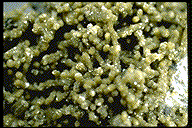The Bastnasite Group
The Bastnasite Group minerals are not entirely structurally related and only loosely chemically related. They are however often associated, even intergrown, and have many similarities. Their structures are based on bastnasite's general structure. The structure of bastnasite is made up of stacks of carbonate ion layers and cerium fluoride layers. The CeF layers form flat hexagonal sheets with each cerium bonded to three fluorines. The carbonate layers are more complex with angled carbonate triangular groups. The other members of the Bastnasite Group must accommodate calciums layers and/or hydroxides in place of the fluorines. This can play a role in distorting or ruining the hexagonal symmetry of bastnasite into trigonal and monoclinic symmetries. However, all members of this group exhibit hexagonal or pseudohexagonal crystal habits.
|
Y=0 |
Y=1 |
Y=2 |
Y=3 |
|
|
X=1 |
Bastnasite - (Ce, La, Y)CO3F, hexagonal |
Synchysite - Ca(Ce, La, Y, Nd)(CO3)2F, monoclinic |
|
no known minerals |
|
X=2 |
no known minerals |
Parisite - Ca(Ce, La)2(CO3)3F2, trigonal Cordylite - Ba(Ce, La)2(CO3)3F2, hexagonal |
no known minerals |
|
|
X=3 |
no known minerals |
no known minerals |
|
no known minerals |








